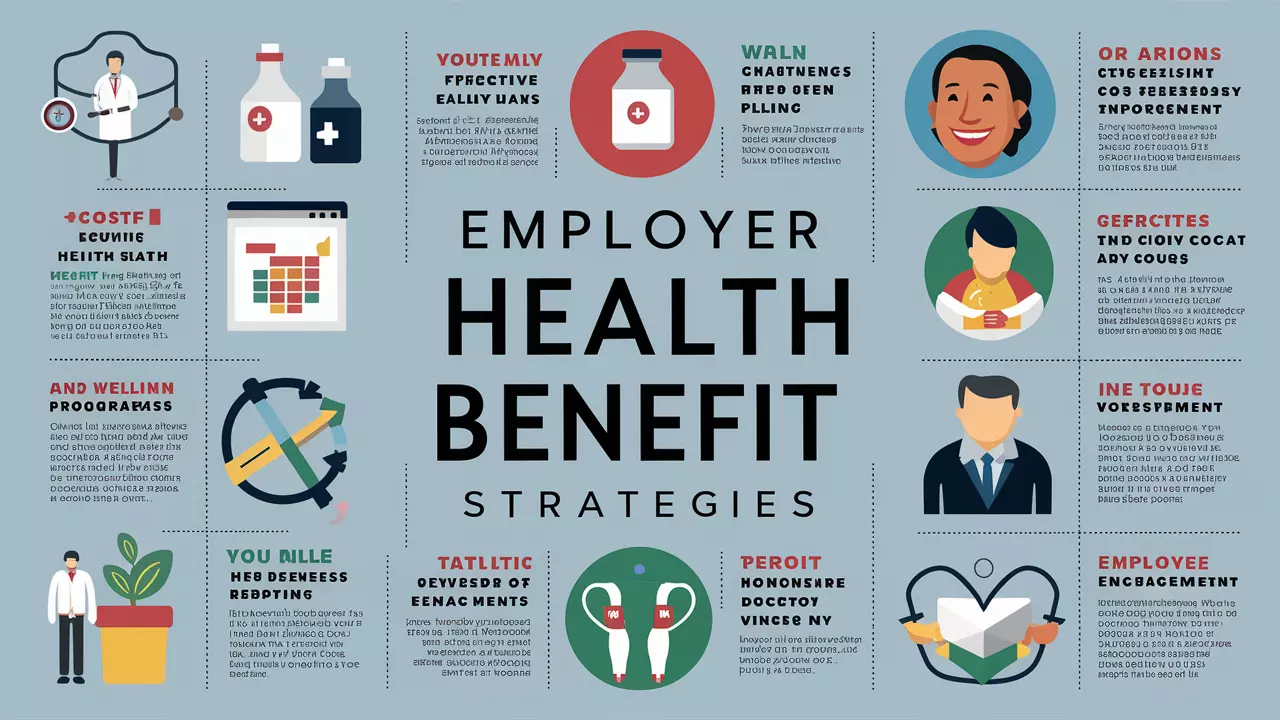Offering comprehensive health benefits is crucial for attracting and retaining top talent. However, HR professionals face challenges such as managing costs, complying with regulations, and meeting diverse employee needs. This blogpost explores key strategies to enhance employer health benefits, focusing on:
- Cost-effective health benefit strategies
- Integrating wellness programs
- Leveraging technology like telehealth services and wearable technology
1. Current Trends in Employer Health Benefits

Telehealth Services
Telehealth services are revolutionizing employer health benefits. These services provide convenient and cost-effective access to healthcare. Employees can consult with healthcare professionals via video calls or messaging, reducing the need for in-person visits. This not only saves time but also reduces healthcare costs for both employers and employees.
- Adoption Rates and Benefits: The adoption of telehealth services has surged, especially post-pandemic. Employers benefit from reduced absenteeism and improved productivity as employees can access healthcare without leaving the office.
- Examples of Successful Implementation: Companies like Amazon and Walmart have integrated telehealth into their employee health benefits. This has resulted in higher employee satisfaction and lower healthcare expenses.
Mental Health and Wellness Programs

Mental health and wellness programs are becoming essential components of employer health benefits. With increasing awareness of mental health issues, employers are prioritizing these programs to support employee well-being.
- Growing Importance and Employee Demand: There is a rising demand for mental health support at the workplace. Providing resources such as Employee Assistance Programs (EAPs) and mindfulness training can significantly enhance employee morale and productivity.
- Types of Programs: Effective programs include counseling services, stress management workshops, and access to mental health apps. Companies like Google and Microsoft offer comprehensive mental health benefits, setting a standard in the industry.
Personalized Benefits
Personalized benefits cater to the diverse needs of the workforce. Using technology, employers can offer customizable health plans that align with individual employee preferences and requirements.
- Customizable Plans: These plans allow employees to choose from a variety of options, such as different levels of health coverage or wellness perks. This flexibility is crucial in meeting the needs of a multigenerational workforce.
- Technology Enabling Personalized Healthcare: Advanced HR software and platforms enable the customization of benefits packages. Tools like Benefitfocus and Zenefits help employers design and manage personalized health benefits efficiently.
2. Cost-Effective Strategies for Managing Health Benefits

Self-Insurance
Self-insurance is a cost-effective strategy where employers assume the financial risk of providing health benefits. This approach can lead to significant savings and greater control over health benefit plans.
- Benefits and Risks of Self-Funding: While self-insurance can reduce costs, it also involves taking on risk. Employers need to ensure they have adequate reserves to cover potential claims. However, the savings from avoiding premiums paid to insurance companies can be substantial.
- Case Studies of Successful Implementation: Companies like Tesla have successfully adopted self-insurance. They manage their healthcare costs more effectively and tailor their plans to better suit their workforce’s needs.
Wellness Incentives
Wellness incentives encourage employees to adopt healthier lifestyles, which can reduce healthcare costs in the long run. These programs reward employees for participating in activities that promote health and well-being.
- Programs that Encourage Healthy Lifestyles: Initiatives like gym memberships, smoking cessation programs, and weight loss challenges can be highly effective. Employees are motivated to stay healthy, leading to lower healthcare costs and increased productivity.
- ROI on Wellness Initiatives: Studies show that wellness programs can yield a positive return on investment. For example, Johnson & Johnson’s wellness program reportedly saved the company $2.71 for every dollar spent.
Preventive Care
Preventive care is crucial for reducing long-term healthcare costs. By encouraging regular check-ups and screenings, employers can help employees detect and address health issues early.
- Encouraging Routine Check-Ups and Screenings: Employers can offer incentives for employees to undergo annual health assessments. Early detection of conditions like diabetes or hypertension can prevent more severe health issues and reduce overall healthcare expenses.
- Partnerships with Local Healthcare Providers: Collaborating with local healthcare providers can make preventive care more accessible and affordable for employees. These partnerships can include discounted services or on-site health screenings.
By implementing these cost-effective strategies, employers can provide valuable health benefits while managing costs effectively.
3. Navigating Healthcare Regulations and Compliance

Key Regulations
Understanding and complying with healthcare regulations is essential for HR professionals managing health benefits. Regulations such as the Affordable Care Act (ACA) and the Health Insurance Portability and Accountability Act (HIPAA) impact how benefits are administered.
- Overview of Relevant Laws: The ACA mandates that employers provide affordable health insurance, while HIPAA protects employee health information. Staying informed about these regulations is crucial for compliance.
- Updates and Changes in Legislation: Regulations can change, affecting compliance requirements. HR professionals must keep up with these changes to avoid penalties and ensure their benefit plans are compliant.
Compliance Strategies
Developing effective compliance strategies helps employers navigate complex healthcare regulations. These strategies involve regular audits, employee training, and the use of compliance tools.
- Steps to Ensure Compliance: Employers should conduct regular audits of their health benefit plans to ensure they meet regulatory requirements. Providing training for HR staff on compliance issues is also essential.
- Tools and Resources for Staying Updated: Online resources like the Department of Labor’s website and professional organizations such as SHRM offer valuable information on healthcare regulations. Utilizing compliance management software can also streamline the process.
Reporting and Documentation
Accurate reporting and documentation are critical components of compliance. Maintaining thorough records ensures that employers can demonstrate compliance during audits or inspections.
- Best Practices for Maintaining Necessary Records: Employers should keep detailed records of all health benefit transactions and communications. This includes enrollment forms, benefit summaries, and compliance reports.
- Audit Preparation and Processes: Preparing for an audit involves organizing all relevant documentation and ensuring that all compliance measures are documented. Employers should have a clear process in place for responding to audit requests.
4. Integrating Wellness Programs

Designing Effective Programs
Creating effective wellness programs involves understanding employee needs and interests. Programs should be tailored to address the specific health challenges and preferences of the workforce.
- Components of a Successful Wellness Program: Key components include physical fitness initiatives, mental health support, and nutritional guidance. Programs should offer a variety of activities to engage different employees.
- Tailoring Programs to Meet Employee Needs: Employers can use surveys and feedback to identify the most desired wellness activities. This ensures higher participation and engagement.
Promoting Participation
To maximize the impact of wellness programs, employers need strategies to promote participation. Effective communication and attractive incentives can encourage employees to take part.
- Strategies to Increase Employee Engagement: Clear communication about the benefits and availability of wellness programs is crucial. Employers can use newsletters, posters, and meetings to inform employees.
- Incentives and Rewards: Offering rewards such as gift cards, extra vacation days, or discounts on health insurance premiums can motivate employees to participate in wellness activities.
Measuring Impact
Evaluating the effectiveness of wellness programs is essential for continuous improvement. Employers should track key metrics to measure the program’s impact on health and productivity.
- Metrics to Track Program Success: Metrics such as participation rates, health outcomes, and employee satisfaction can provide insights into the program’s effectiveness. Employers should also monitor healthcare cost savings.
- Case Studies of Impactful Wellness Programs: Companies like PepsiCo have seen significant improvements in employee health and reductions in healthcare costs through their wellness programs. These success stories can serve as inspiration for other employers.
For More Information Read More Article
5. Leveraging Technology in Health Benefits

Health Management Apps
Health management apps offer employees convenient ways to monitor and manage their health. These apps can track physical activity, diet, and other health metrics.
- Benefits of Mobile Health Management Tools: Mobile apps provide real-time feedback and personalized health recommendations. They can also remind employees to take medications or schedule doctor appointments.
- Popular Apps and Their Features: Apps like MyFitnessPal and Fitbit are popular among employees. These apps offer features such as calorie tracking, exercise logging, and progress visualization.
Wearable Technology
Wearable technology, such as fitness trackers and smartwatches, can enhance employee health monitoring. These devices provide valuable data that can be integrated into wellness programs.
- Using Wearables to Monitor and Encourage Health: Wearables can track steps, heart rate, and sleep patterns. Employers can use this data to design targeted wellness initiatives.
- Integrating Data from Wearables into Benefit Programs: Data from wearables can be used to reward employees for meeting health goals. For example, employees who achieve a certain number of steps per day might receive incentives.
Digital Health Platforms
Digital health platforms offer comprehensive solutions for managing employee health benefits. These platforms can include telehealth services, health coaching, and wellness resources.
- Platforms that Offer Comprehensive Health Management: Platforms like Teladoc and Livongo provide a range of services from virtual doctor visits to chronic disease management. These platforms can streamline access to healthcare for employees.
- Benefits of Digital Health Coaching and Telemedicine: Digital health coaching offers personalized advice and support, while telemedicine provides easy access to healthcare professionals. Both services can improve employee health outcomes and reduce costs.
6. Effective Communication and Employee Engagement

Clear Communication Strategies
Effective communication is key to ensuring employees understand and utilize their health benefits. Clear and consistent messaging can help demystify complex benefit options.
- Methods for Explaining Benefits Clearly: Use simple language and visual aids to explain health benefits. Employers can create brochures, videos, and FAQs to make information accessible.
- Tools for Ongoing Communication: Utilize newsletters, intranet portals, and regular meetings to keep employees informed about benefit updates and changes. Interactive tools like webinars can also be effective.
Employee Feedback
Gathering and acting on employee feedback is essential for improving health benefit programs. Feedback helps identify areas of improvement and ensures the benefits meet employee needs.
- Gathering and Acting on Employee Feedback: Use surveys, suggestion boxes, and focus groups to collect feedback. Analyze the responses to identify common themes and areas for enhancement.
- Incorporating Feedback into Benefit Program Design: Adjust benefit offerings based on employee feedback to increase satisfaction and engagement. For example, if employees express a need for better mental health support, consider adding more resources or services.
Education and Resources
Providing education and resources helps employees make informed decisions about their health benefits. Empowered employees are more likely to utilize the benefits effectively.
- Providing Resources to Help Employees Understand and Use Their Benefits: Offer workshops, seminars, and one-on-one consultations to educate employees about their benefits. Provide online resources such as guides and tutorials.
- Workshops and Seminars on Health and Wellness Topics: Host regular events that cover various health and wellness topics. These can include stress management, nutrition, and fitness workshops.
By implementing effective communication strategies and engaging employees, employers can maximize the impact of their health benefit programs.
7. Case Studies and Real-Life Examples
Case Study 1: Mid-Sized Tech Company
A mid-sized tech company faced challenges in managing healthcare costs while providing comprehensive benefits. By implementing telehealth services and a wellness program, they achieved significant cost savings and improved employee satisfaction.
- Overview of Their Benefit Strategy: The company offered telehealth services, fitness incentives, and mental health support. This combination addressed diverse employee needs and reduced absenteeism.
- Challenges Faced and Solutions Implemented: Initial resistance to telehealth was addressed through education and incentives. The wellness program’s success was measured through increased participation and positive health outcomes.
Case Study 2: Large Corporation
A large corporation focused on personalized benefits to meet the needs of its diverse workforce. They used advanced HR software to offer customizable health plans and wellness programs.
- Innovative Approaches to Health Benefits: The corporation implemented a flexible benefits platform, allowing employees to choose from various health and wellness options. This increased employee satisfaction and engagement.
- Impact on Employee Satisfaction and Retention: Personalized benefits led to higher employee retention rates and improved morale. The company reported a reduction in healthcare costs due to proactive health management.
Case Study 3: Startup Environment
A startup balanced cost management with comprehensive coverage by adopting self-insurance and leveraging technology. They also integrated digital health platforms to enhance employee health benefits.
- Balancing Cost with Comprehensive Coverage: Self-insurance provided control over healthcare spending, while digital health platforms offered accessible and cost-effective healthcare solutions.
- Creative Benefit Offerings Unique to Startups: The startup offered innovative perks such as wellness stipends and mental health days. These benefits were well-received by employees and contributed to a positive workplace culture.
Conclusion
Employers must continuously adapt their health benefit strategies to stay competitive and meet employee needs. By leveraging cost-effective strategies, integrating wellness programs, and using technology, companies can create comprehensive and attractive health benefits packages.
Staying informed about trends and regulations, and effectively communicating with employees, ensures the success of these programs. Ultimately, a well-designed health benefits strategy can lead to improved employee satisfaction, retention, and overall company success.

James Wilson is the insightful financial writer behind the wealth of knowledge on WealthWaves. With a keen understanding of finance and a passion for helping others navigate the complexities of money management, they specialize in crafting informative articles, practical tips, and expert advice to empower readers on their journey to financial freedom.
Join James Wilson on WealthWaves to embark on a path towards financial success and prosperity.








